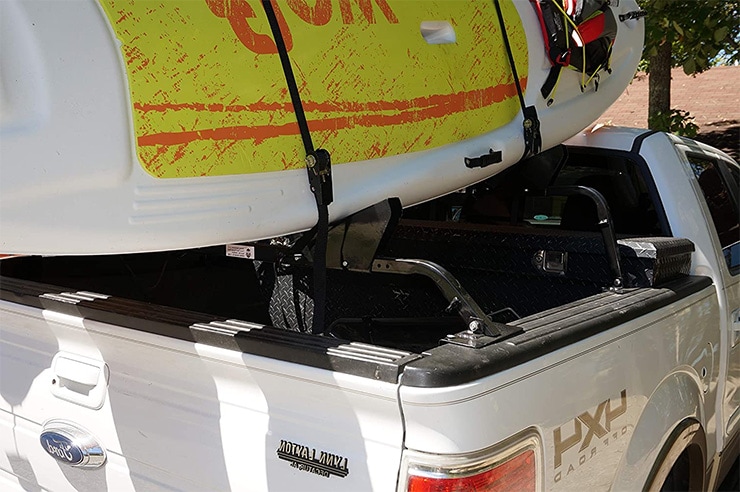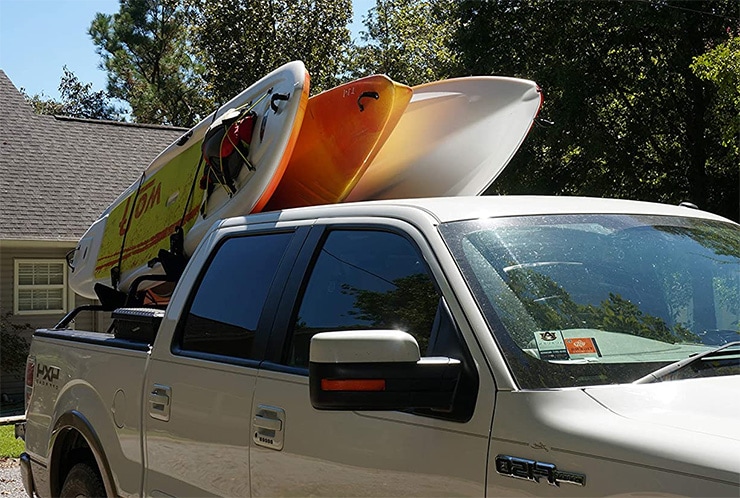Having a truck is a great way to transport your paddle board around without a roof rack, especially if you have a rigid board, rather than an inflatable SUP board. Trucks can simplify transport and allow you to easily load and unload your paddle board without issue.
Today we’re going to explore how to safely transport your paddle board, how to use a soft rack system, and using SUP tie down straps to properly get your board from one destination to another.
How to Transport a Paddle Board in a Truck Safely
If you’re traveling around with a paddle board, especially ones that are 11 to 12 ft in length, you won’t be able to avoid having your paddle board sticking out of the back of your truck bed. Allowing your board to stick out of the bed of your truck is not ideal – but some people still do this.
It’s not so much the paddle board sticking out of the truck bed that you should worry about, but rather whether or not it is securely tied down. Regardless of if you’re traveling with one board or multiple boards, it’s important that you properly secure them during transport.
Transporting a rigid paddle board is obviously more difficult than with inflatable boards. The latter can simply be deflated and packed in a board bag, whereas a hard paddle board will need to be lashed down. You could opt for a hard rack attached to the roof of your truck, but if you’re wanting to transport your board in your truck bed then you’ll need a different solution.
Use The Right Straps to Secure Your Paddle Board
When securing your paddle board, it’s important to use the right type of straps for ultimate safety. Common straps you should look for include:
- Cam straps – easiest to use, stay secure with a locking buckle.
- Ratchet straps – Use safety lock “S Hooks”, great for transporting multiple boards.
- Nose and tail line straps – Provide additional security to the noise and tail of your paddle board.
Nylon or rubberized straps are also best because they won’t damage your vehicle or your paddle board.
How to Secure Your Paddle Board in Your Truck Bed
When you strap your paddle board down, open up the tailgate so you can lay your paddle board down flat. Put the nose of your board in first (because it is heavier). You may want to add some soft weight like a sandbag over the nose to help keep it down.
To create some friction (which will help keep your board from moving around), use a foam base over your paddle board. You can also protect the sides by using two foam blocks or a pool noodle cut in half.
Secure your board by wrapping the straps horizontal and vertically over the board and securing them to the attachments on your truck’s bed. Use stern straps or a ratchet strap as the main method for security. Use clips on your truck to attach strap hooks or utilize your car door to help secure the straps.
Using a red flag attached to the nose of your paddle board is another method for safely transporting your paddle board. The red flag will alert drivers that you have a long load.
Use a Truck Bed Rack for Your Paddle Board

If you’re someone who takes their paddle board out often, then you may want to go ahead and invest in a truck bed rack for your paddle board.
A truck bed rack is essentially a hard rack system and works similarly to a rack found on a car’s roof. The difference is bed racks give you more flexibility and versatility as far as what you can transport. A rack like this one from Viking Solutions is a good option and super simple; once it’s installed you simply need to set the paddle board in one of the grooves and then use your straps to tie it down.
It’s easy to secure two cam straps or ratchet straps onto a rack. You don’t have to worry about whether or not the cam or ratchet straps become loose during the drive. And best of all, a rack simplifies transport if you’re going to be loading and unloading your paddle board alone.
Use a Truck Bed Extender for Your Paddle Board
A truck bed extender is another nifty way to keep your power board from sticking out of your vehicle. Extenders are easy to install, easy to use, and are one of the safest ways to transport your power board.
A bed extender like this one installs directly underneath your truck’s frame and extends out along the tailgate of your truck. When you lay your tailgate down flat, your paddle board will have extra support to lay flat against the extender.
Some extenders are adjustable and allow you to move the frame closer or further away from your truck’s bed. Either way, make sure that you use a towel or some sort of padding to help protect the underside of your paddle board. This will keep debris from flying up underneath the extender and hitting your board.
How to Transport Multiple Paddle Boards on Your Truckbed
Transporting several boards in the bed of your truck can be a little tricky. In order to do it safely, however, you’ll need a couple of silicone or rubber straps and some thin soft racks that you can lay in between the paddle boards.
If you don’t have any soft racks, you can use pool noodles instead. The pool noodles work much like soft racks because they help to create friction between the boards.
Lay your boards one on top of another with your thin soft rocks or towels in between each paddle board. If you have any removable fins, make sure to take these off first to keep from damaging the other boards.
This will allow the boards to have some friction between them so that they don’t move around during transport. Next, use a bungee cord, cam straps, or ratchet straps over the boards and onto your truck’s bed clippings.
Use the Right Amount of Tension When Strapping Your SUP
Be sure that you’re not securing the paddle boards too tightly or too loosely. You want there to be just enough tension that the boards don’t move, but not so much that your paddle board gets damaged.
This is where pool noodles can come in handy once again. Use a pool noodle between the board and the straps to help create some tension. Much in the way you would use soft racks on your car roof, you’ll want to use the soft racks on the base of your board while on the truck.
Final Tips for Transporting Your Paddle Board in Your Truck Bed
When you’re driving around with a board on your vehicle, you’ll want to practice extra caution as you drive. Consider these tips for safe transport.
Drive Slowly
No matter how well secured your paddle board is, you should always make it a point to drive slowly when you’re moving from one location to another.
Anything can happen while you’re on the road, and the last thing you want is a paddle board getting injected from your truck and onto the roadway. Even if your paddle board is secured well onto your vehicle, you can run into other issues which may damage or even puncture your pedal board.
Keep Your Ears Open For Weird Noises
As you drive, keep your ears open for any abnormal noises such as metal clanging, straps moving around, and any other indication that your pedalboard might be coming loose.
When you strap in your paddle board, drive slowly and then start picking up speed so you can hear whether or not everything is still in place. If you hear something that doesn’t sound quite right, pull over and do a quick inspection.
First Timers: Pull Over, and Check Straps
If it’s your first time strapping your paddle board into your vehicle, It doesn’t hurt to pull over after a short distance and then double-check the straps.
Strapping a paddle board into your vehicle for the first time can be a little intimidating, especially if you’re not quite sure if you’re doing it right. The best way to get a gauge of how well your board is strapped in is by driving a couple of minutes, picking up speed, and then pulling over to check the straps.
Inspect Your Soft Rack or Foam Pad
As you check your cam strap bucks inspect to make sure that everything is still in place, that any soft rack used has not moved, and that the board itself has not moved.
If you are using nose and tail lines, make sure that these are still holding the right amount of tension to keep your board in place. If you have used foam blocks as support, make sure that the foam blocks have not moved either.
If you noticed that the cam straps, soft rack, or the cam buckles have moved or shifted, this might mean that your board is not properly secured. Do an inspection of your cam buckle and nose and tail lines to make sure everything is where it should be.
Avoid Highways (If You Can)
When you are driving on a highway, the powerful wind hitting your paddle board might cause it to loosen, or even get damaged. In a worst case scenario, the wind has the ability to lift up a board if it’s not properly secured.
If you’ve secured your paddle board properly, chances are you’ll be just fine driving on the highway. However, if you are able to avoid it, it’s best to do so. If you don’t have a choice and need to get on the highway, Make sure you’re not speeding and try to stay close to the exit lane. This way, if you do need to get off of the highway quickly, you can easily do so.
As you drive on the highway, if you begin to hear noises that have you questioning the integrity of the straps, pull over and double check the security of your stand up paddle board.
Noises to keep an ear out for include a sudden change in how the strap is hitting the wind, clanging noises, or squeaking noises from either the foam block or the paddle board itself.
Consider a SUP Lock
Whenever you take a paddle board out, it’s best to go directly from your home base to the docking spot. However, in the instances where you do need to make a pit stop at a restaurant, shop, or other destination, it can be handy to have a SUP lock on your board.
A SUP lock like this one allows you to secure your SUP to your vehicle so that it doesn’t get stolen. SUP locks can also come in handy if you’re going camping somewhere overnight and want to make sure your SUP stays secured.
Final Thoughts
Once you get the hang of transporting a paddle board in your truck, setting it up on your truck bed or inside your vehicle will become second nature. The key to safely and securely transporting your SUP is knowing how to set up your straps and how to use different rack systems like a truck tailgate extender, soft rack system or a truck rack.

